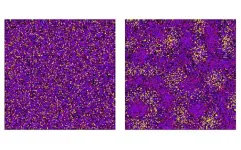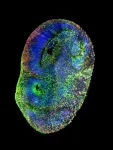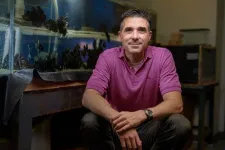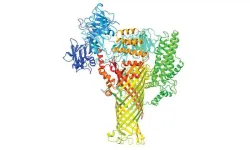(Press-News.org) Scientists call long-spined sea urchins “the lawn mowers of the reefs” because they eat algae that could otherwise smother reef ecosystems and kill corals.
That’s why researchers affiliated with the University of Florida Tropical Aquaculture Lab (TAL), who work at the Florida Aquarium’s Conservation Campus in Apollo Beach, are trying to raise as many urchins as possible.
Aaron Pilnick, a post-doctoral researcher at TAL, led newly published research that identifies substrates that help long-spined sea urchins – scientifically known as Diadema -- grow from larvae to juveniles in a lab setting. A substrate is the surface on the sea floor on which an organism lives or obtains its nourishment.
Researchers found that sea urchin larvae grew into juvenile sea urchins on two types of algae commonly found on the floor of Caribbean coral reefs. They also found that the characteristics of a substrate, such as a rough texture, are important.
To reach their findings, UF/IFAS scientists relied on the Florida Fish and Wildlife Conservation Commission to bring adult urchins from the Florida Keys to the Florida Aquarium Conservation Campus. There, researchers induced the urchins to spawn in captivity.
Larvae grew in a highly specialized, 10-gallon fish tank for about 40 days. Then, scientists used a microscope to document the size, shape and structure of live specimens during the final stages of larval development. They then transferred the larvae to petri dishes, containing seawater and various substrates and recorded if they became juvenile sea urchins.
Restoring the long-spined sea urchin is critical because in the early 1980s, disease nearly wiped out the species. That die-off almost immediately led to algae overgrowing reefs.
“We are trying to restore these vital ecosystems by growing corals in ocean nurseries and planting them back to areas where they used to thrive. However, these reefs also need more urchins to protect corals from algae,” said Pilnick, who led the research while a doctoral student in the UF/IFAS College of Agricultural and Life Sciences.
To restore sea urchins, it’s important to know their growth patterns. Urchin larvae float and swim around the ocean until they find a place on the sea floor to attach and transform into a juvenile sea urchin.
This process, called “settlement,” is similar to how a pupa turns into a butterfly. By developing the ability to grow this species, scientists can study settlement in the lab and infer certain things about its ecology.
Now that UF/IFAS scientists have identified conditions for long-spined sea urchins to grow from larvae to juveniles, they’re studying how to get them to mature to adulthood, said Josh Patterson, a UF/IFAS associate professor of restoration aquaculture in the School of Forest, Fisheries, & Geomatics Sciences, Pilnick’s supervisor and a Florida Sea Grant-affiliated researcher.
“For many marine animals, the transition from larvae to adults is a critical part of the life cycle. This research is groundbreaking because it’s the first time this transition has been investigated in this important species,” said Patterson, a co-author on the new study.
END
Scientists find good places to grow long-spined sea urchins, a starting point to restore ‘the lawn mowers of the reefs’
2023-09-13
ELSE PRESS RELEASES FROM THIS DATE:
Could a breakdown in the brain’s networks allow infections to contribute to Alzheimer’s disease?
2023-09-13
The human microbiome includes the genetic material of more than 100 trillion tiny microorganisms – fungi, yeast, bacteria, and even viruses, most of which hang out in our gastrointestinal tract to serve as guardians of our health. But when a healthy microbiome gives way to an imbalance — a “pathobiome” — any number of health problems can occur — from rheumatoid arthritis, to bacterial vaginosis. New data published this month in the journal Frontiers in Cellular and Infection Microbiology, from researchers at Drexel’s College of Medicine, gives more evidence to the possibility that developing a pathobiome ...
Cleaning products emit hundreds of hazardous chemicals, new study finds
2023-09-13
WASHINGTON – A peer-reviewed study by Environmental Working Group scientists has found unsettling details about the potential health risks of common household cleaning products.
The study, published today in Chemosphere, analyzed 30 cleaning products, including multipurpose and glass cleaners, air fresheners and more. The study revealed that these everyday products may release hundreds of hazardous volatile organic compounds, known as VOCs.
Researchers tested both conventional products and “green” cleaning products and detected a total of 530 unique VOCs in the 30 products. Of these, 193 VOCs were hazardous – identified ...
Statement from the European Respiratory Society on results of the European Parliament vote on revision of the Ambient Air Quality Directive
2023-09-13
Professor Zorana Jovanovic Andersen, Chair of the European Respiratory Society’s Environment and Health Committee and based at the University of Copenhagen, said:
“Today’s vote by the European Parliament to strengthen the legally binding limit values for air quality is an important step in the right direction toward clean air for all, even though the full alignment with World Health Organization was moved from 2030 to 2035. As we prepare for the negotiations with the Council, this is great news for all European citizens, especially the millions who live ...
Majority rule in complex mixtures
2023-09-13
The very first life on earth is thought to have developed from “protocells” – liquid mixtures of many different types of molecules. Researchers from the University of Göttingen have now shown that in such mixtures, small imbalances in the number of molecules of different types can have an unexpected effect. A surprising interplay with the complex pattern of interactions strongly amplifies such imbalances – meaning that a type of molecule that is only slightly in the majority can almost entirely separate out from the others. ...
CHOOSEn fate: one brain organoid’s tale on Autism
2023-09-13
Does the human brain have an Achilles heel that ultimately leads to Autism? With a revolutionizing novel system that combines brain organoid technology and intricate genetics, researchers can now comprehensively test the effect of multiple mutations in parallel and at a single-cell level within human brain organoids. This technology, developed by researchers from the Knoblich group at the Institute of Molecular Biotechnology (IMBA) of the Austrian Academy of Sciences and the Treutlein group at ETH Zurich, ...
Pixel-by-pixel analysis yields insights into lithium-ion batteries
2023-09-13
CAMBRIDGE, MA -- By mining data from X-ray images, researchers at MIT, Stanford University, SLAC National Accelerator, and the Toyota Research Institute have made significant new discoveries about the reactivity of lithium iron phosphate, a material used in batteries for electric cars and in other rechargeable batteries.
The new technique has revealed several phenomena that were previously impossible to see, including variations in the rate of lithium intercalation reactions in different regions of a lithium iron phosphate nanoparticle.
The paper’s most significant practical finding — that ...
Long-term quality of life after out-of-hospital cardiac arrest
2023-09-13
About The Study: In this survey study of 2,552 survivors of cardiac arrest in Denmark, health-related quality of life up to 20 years after the event was consistently high across follow-up periods and comparable to the general Danish population. These findings support resource allocation and efforts targeted to increasing survival after out-of-hospital cardiac arrest.
Authors: Harman Yonis, M.D., of Nordsjallands Hospital in Hillerod, Denmark, is the corresponding author.
To access the embargoed study: Visit our For The Media website at this link https://media.jamanetwork.com/
(doi:10.1001/jamacardio.2023.2934)
Editor’s ...
Economic evaluation of extended-release buprenorphine for persons with opioid use disorder
2023-09-13
About The Study: In this economic evaluation of extended-release buprenorphine compared with transmucosal buprenorphine for the treatment of opioid use disorder, extended-release buprenorphine was not associated with efficient allocation of limited resources when transmucosal buprenorphine was available. Future initiatives should aim to improve retention rates or decrease costs associated with extended-release buprenorphine.
Authors: Juliet M. Flam-Ross, B.A., of the London School of Hygiene and Tropical Medicine in London, and Sabrina A. Assoumou, M.D., M.P.H., of the Boston ...
Solving stickiness sustainably
2023-09-13
WEST LAFAYETTE, Ind. – Glue holds the world together. Without adhesives, much of modern human civilization — including our cellphones, cars, furniture, walls and the packages arriving on our doorstep — would simply fall apart.
The trouble with all those adhesives is that they are not sustainable. A team of chemists at Purdue University led by Jonathan Wilker, professor of chemistry in the College of Science and of materials engineering, aims to change that with a new, completely sustainable adhesive system. The team’s findings were released in a paper in Nature.
Additional Information
Shellfish ...
Mysterious family of microbial proteins hijack crops’ cellular plumbing
2023-09-13
DURHAM, N.C. -- Many of the bacteria that ravage crops and threaten our food supply use a common strategy to cause disease: they inject a cocktail of harmful proteins directly into the plant’s cells.
For 25 years, biologist Sheng-Yang He and his senior research associate Kinya Nomura have been puzzling over this set of molecules that plant pathogens use to cause diseases in hundreds of crops worldwide ranging from rice to apple trees.
Now, thanks to a team effort between three collaborating research groups, they may finally have an answer to how these molecules make plants sick -- and a way to disarm them.
The findings appear Sept. 13 in the journal Nature.
Researchers ...




